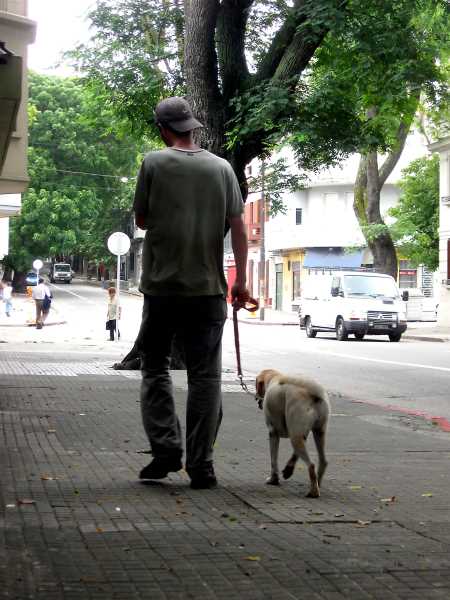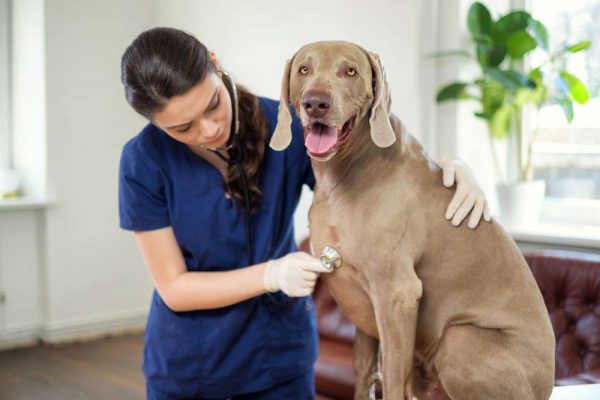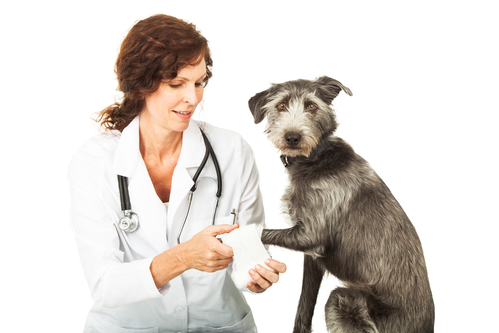Lameness in Dogs
Why is your dog limping? Lameness in dogs is a symptom of illness or injury, not a specific disease. If you see your Weimaraner dog limping or hesitating to put her full weight on one or more legs, you need to pay attention.
Of course there are different degrees of lameness, and some are more serious than others. And some dogs just seem to be more prone to injuries than others.

Symptoms of Dog Lameness
Of course, if your dog is limping, you’ll see it right away. Dog lameness is easy to recognize. For example, your dog may simply refuse to bear weight on a limb. You will notice.
If your Weimaraner has a musculoskeletal system disorder, you will notice weakness in one or more limbs. And if you look at the joint more closely, you may see redness and swelling.
Older dogs who are lame, usually carry the affected leg close to the body, with its joints bent.
There is a difference between limping and lameness. If your dog uses his leg carefully or cautiously, but can still bear some weight, he has a limp. If he doesn’t put any weight at all on his leg, he is lame.
The most common symptoms of dog lameness are:
- Limping
- Refusing to get up from a lying down position
- Unable to extend his limb to make it straight (usually due to pain or swelling)
- Unable to bend a leg at the joints
- Leg dangling with no muscle tension
- Unable to support any weight on the affected leg
- Hesitating or unable to climb up or down stairs
- Crying or yelping when touched or weight is placed on the limb
Additionally, when your dog has problems with her muscles and joints, she may also have problems with:
- Her urinary tract system
- Stomach issues
- Problems with her circulatory system.
What are the Reasons a Dog could be Limping?

There are a number of reasons that a dog can become lame. In order to treat your dog, you or the vet need to determine the cause of your dog’s limping.
With lameness, it is very important to consider your dog’s history.
Ask yourself these questions:
- When did you first notice your dog’s limping or lameness?
- Was it worse at a particular time of the day? For example, was it worse late in the day or when your dog first awakened in the morning?
- Did you notice that the onset of lameness was sudden or gradual?
- Has your dog been injured recently? Did the limping start while you were hunting with your dog? What was he doing?
In addition to a simple strain or sprain, there are other physical injuries that cause limping or lameness in dogs.
Foot pad trauma
Your dog’s foot pad is more tender than you may realize. Foot pads can be bruised or injured. This is especially true for hunting dogs.
In the winter, salt and chemicals from de-icing the roads and sidewalks can irritate your dog’s foot pads. This is easy to prevent. Simply wash or wipe your dog’s foot pads after a winter walk where chemicals have been spread.
On the other hand, in the summer, hot macadam or pavements can burn your Weimaraner’s foot pads. To prevent this kind of injury, make sure your dog doesn’t stand for long periods on hot surfaces.
Foreign bodies in a Foot Pad
Check the bottom of your dog’s foot. Sometimes a little pebble or a thorn can cause a dog to limp.
If your dog suddenly starts limping while hunting, this is the first thing to check. A simple thing, Weimaraners who are bold and unafraid while hunting, often do get into thorns.
Fracture
With a fracture, you might see redness and swelling. However, not always. If you can’t see anything obviously amiss, consider that your dog may have broken a bone.
Hip dislocation
If your Weim has a hip dislocation he will cry or yelp when you touch his hip. And he will refuse to put any weight on the affected leg.
Infections
Not terribly common, your dog could have an infection in the bone, joints, or muscles. More common, a cut or scratch that you didn’t notice, can become infected. When an injury is infected, your dog will have pain.
Muscle trauma or a bruise
If your dog was more active than usual, she could be suffering from overuse—just like you. When you have a sedentary job during the week and play hard over the weekend, you can end up sore and stiff on Monday morning. Likewise, so can your dog.
Patellar luxation
This is common in some breeds. Luxating patella is a dislocation of the knee or patella. It is very painful and will cause limping.
The condition can be inherited, and if your dog has this, he may need surgery to correct it.
Torn cruciate ligament or torn meniscus
Your vet will decide if either of these are the issue. In this case, the condition will need surgery to be repaired.
Physical Injury

For younger dogs, the most common reason for lameness is some kind of injury. And it doesn’t have to be trauma, like being hit by a car.
The injury can be caused by a common activity like jumping off a bed or sofa or slipping on the ice.
Or you may see your dog limping after a day of strenuous activity or play.
Often the injury is not serious. It could be the same as a sprain or strain in people, often called overuse syndrome or sore dog syndrome in dogs.
Most of the time, with a little rest, this kind of injury will heal by itself in a short time. Keep an eye on your dog for a while, and if she is getting better, you probably don’t need to run to the vet.
On the other hand, especially with older dogs, the lameness can be a sign of something more serious.
Diseases that Cause Lameness in Dogs
Especially as your dog ages, she can get diseases that cause lameness. The most common cause of lameness in older dogs is osteoarthritis.
Other possibilities are:
Degenerative Disk Disease
Degenerative disk disease results in compression of the spinal cord and nerves. This is most common in small dog breeds like the Bichon Frise or miniature poodle. For small breeds, the disks in the spine can start to deteriorate when the puppy is just a few months old.
Lyme Disease
Dogs get ticks and ticks carry Lyme disease and other tick borne diseases.
Lyme is epidemic in the northern states and becoming more common all over the U.S. If untreated, Lyme disease becomes a severe form of arthritis. Your dog will become severely disabled.
Fortunately, when caught in time and treated, Lyme disease is not an ongoing problem for dogs.
Fibrous Osteodystrophy
This condition creates an imbalance of calcium and phosphorous in the body and can lead to lameness and fractures because the bones are weak and brittle.
OCD or Osteochondrosis
This is a disease that affects the cartilage of the shoulder, elbow, and knee joints. It is most often seen in large dog breeds like Weimaraners, that grow fast. Lameness starts when the dog is 6-9 months old.
Heredity plays a part in this condition, so choosing a good breeder will go a long way toward prevention.
When to See the Vet
It is important to observe your dog’s symptoms for a short while before running to the vet. However, don’t try to diagnose your dog’s condition yourself. If you get it wrong, you could end up doing more damage to your dog!
Keep an eye on your dog and her behavior. If your dog seems to be getting better in a couple of days, limit her activities and keep an eye on her. Rest is often all that is needed.
But, if your dog does not improve, you may need to take further action.
Here are some reasons to make an appointment with your vet:
- Your dog lacks energy and is lethargic. Your vet will want to make sure your dog does not have Lyme disease or another tick-borne disease.
- You do not remember an incident when your dog hurt herself.
- She did not have a day of strenuous activity right before she started limping.
- Your Weimaraner has been resting for a day or two and is not getting better.
- You have a nagging feeling that something is seriously wrong.
Making a Diagnosis
To make a diagnosis, your vet will first question you about your pet’s recent activities and if you know about any injuries. The vet will also want to know if your dog has shown any signs of illness, like inactivity, not eating or even vomiting and diarrhea.
The vet will do a physical lameness exam which includes:
- Observing your dog when she is resting
- Watching her get up and walk
- Determining if the lameness is in one leg or more
- Feel the joints for swelling and warmth.
- Does your dog wince or cry when a joint is touched?
- Check range of motion – How far can your dog move her limb?
- Is there a noise or grating or crackling sound in the joint when it is moved?
In addition, your vet may want to do some other tests to see what is going on in your dog’s joints. These include x-rays, MRI (magnetic resonance imaging), ultrasound tests, or a CT scan.
Another possibility is doing an arthroscopy. Your vet will insert a little camera into the joint to see the inside of the joint. This procedure is also used to remove dead or damaged cartilage or ligaments. It is relatively non-invasive and healing is quick afterwards.
Treatment of Lameness
Treatment depends on the diagnosis. Different injuries or diseases are treated with different medications or approaches.
Sprains and Strains
Your vet may suggest something like this to help your dog recover:
- Apply cold immediately after an injury, for the first 24 hours. Keep a cold pack or ice on the injury for 15 minutes, take off and rest for 1 hour. Then repeat.
- Apply heat after the first 24 hours. Heat packs (or a hot water bottle) increase the circulation and reduce stiffness. Heat can also speed up healing.
- Restrict your dog’s activity for a few days. Keep your dog on a leash for walks, even if she is used to running free.
- Sometimes using a joint brace for support helps your dog move better and more confidently, with less pain.
Other Conditions
Depending on your dog’s diagnosis, your dog’s treatment will be determined by your vet. Treatment may include medications to reduce inflammation and probably will include something for pain management.
If your dog has arthritis, treatment will be long term, but there are many excellent products for sale that will help you and your dog.






Leave a Reply